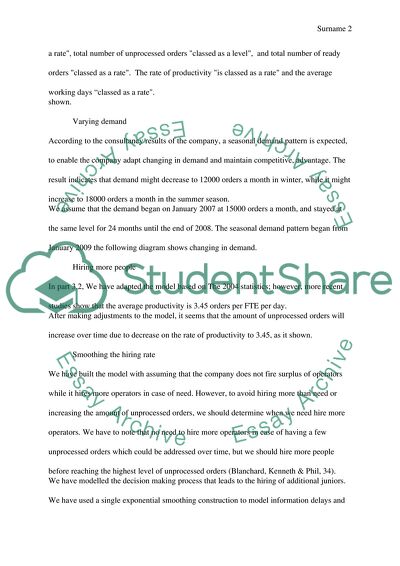
- Home
- Free Samples
- Premium Essays
- Editing Services
- Extra Tools
- Essay Writing Help
- About Us
- Studentshare
- Subjects
- Miscellaneous
- Managment paper
Managment paper - Essay Example
We will examine total…

- Subject: Miscellaneous
- Type: Essay
- Level: Masters
- Pages: 4 (1000 words)
- Downloads: 0
- Author: kylee34
Extract of sample "Managment paper"
The length of the training period” is classed as a rate”, the rate of retirements” is classed as a rate” and the rate of resignations “classed as a rate”. The company provides some statistics and measurements for 2004. These statistics indicate that the average working is 21 days per month, the average productivity for seniors is between 3.4 and 3.8 orders per FTE per day. The average productivity for juniors is between 1.7 and 1.9 orders per FTE per day the average number of new orders is 15000 orders per month and current numbers of unprocessed orders are 10000 orders.
We will examine the relationship between the human resources of this company and the workload that has to be processed every month. This part examines the relationship between the human resources and the workload every month. It takes into account main factors such as the total number of new orders "classed as a rate", total number of unprocessed orders "classed as a level", and total number of ready orders "classed as a rate". The rate of productivity "is classed as a rate" and the average working days “classed as a rate".
According to the consultancy results of the company, a seasonal demand pattern is expected, to enable the company adapt changing in demand and maintain competitive, advantage. The result indicates that demand might decrease to 12000 orders a month in winter, while it might increase to 18000 orders a month in the summer season. We assume that the demand began on January 2007 at 15000 orders a month, and stayed at the same level for 24 months until the end of 2008. The seasonal demand pattern began from January 2009 the following diagram shows changing in demand.
We have built the model with assuming that the company does not fire surplus of operators while it hires more operators in case of need. However, to avoid hiring more than need or increasing the amount of
...Download file to see next pages Read MoreCHECK THESE SAMPLES OF Managment paper
Operation manegement (term paper)
Operations Management - Discussion Paper
Evolution of Managment Paper
Strategic Management Research Paper
WK3_Performance Management Paper
Management Planning Paper
Strategic Management - News Paper business
Management Roles Paper

- TERMS & CONDITIONS
- PRIVACY POLICY
- COOKIES POLICY